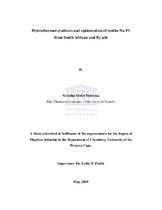| dc.description.abstract | Millions of tonnes of fly ash are generated worldwide every year to satisfy the large demand for energy. Management of this fly ash has been a concern and various approaches for its beneficial use have been investigated. Over the last two decades, there has been intensive research internationally that has focused on the use of different sources of fly ash for zeolite synthesis.However, most of the studies have concentrated on class C fly ash and very few have reported the use of South African class F fly ash as feedstock for zeolite synthesis.Class F fly ash from South Africa has been confirmed to be a good substrate for zeolite synthesis
due to its compositional dominance of aluminosilicate and silicate phases. However, because differences in quartz-mullite/glass proportions of fly ash from different sources produces impure phases or different zeolite mineral phases under the same activation conditions, the present study focused on optimization of synthesis conditions to obtain pure phase zeolite Na-P1 from class F South African coal fly ash. Synthesis variables evaluated in this study were; hydrothermal treatment time (12 - 48 hours), temperature (100 – 160 oC) and addition of varying molar
quantities of water during the hydrothermal treatment step (H2O:SiO2 molar ratio ranged between 0 - 0.49).Once the most suitable conditions for the synthesis of pure phase zeolite Na-P1 from fly ash were identified, a statistical approach was adopted to refine the experiments, that was designed to evaluate the interactive effects of some of the most important synthesis variables. In this case, the four synthesis variables; NaOH concentration (NaOH: SiO2 molar ratio ranged between 0.35– 0.71), ageing temperature (35 oC – 55 oC), hydrothermal treatment time (36 - 60 hours) and temperature (130 oC – 150 oC) were studied. The response was determined by evaluating the improvement in the cation exchange capacity of the product zeolite.The starting materials (fly ashes from Arnot, Hendrina and Duvha power stations) and the synthesized zeolite product were characterized chemically, mineralogically and morphologically by X-Ray fluorescence spectrometry, X-ray powder diffraction, scanning electron microscopy, and transmission electron microscopy. Other characterization technique used in the study were Fourier transform infrared spectroscopy to provide structural information and also monitor evolution of crystallinity during synthesis, as well as cation exchange capacity to determine the amount of exchangeable positively charged ions. Nitrogen adsorption was used to determine the surface area and porosity, and inductively coupled mass spectrometry for multi-elemental
analysis of the post-synthesis supernatants.The results from the X-ray diffraction spectroscopy showed that the most pure zeolite Na-P1 phase was achieved when the molar regime was 1 SiO2 : 0.36 Al2O3 : 0.59 NaOH : 0.49 H2O and at synthesis conditions such that ageing was done at 47 oC for 48 hours while the hydrothermal treatment time and temperature was held at 48 hours and 140 oC, respectively. Results from statistically designed experiments show that there was a distinct variation of phase purity with synthesis conditions. From the analysis of linear and non linear interactions, it was found that the main effects were ageing temperature and hydrothermal treatment time and temperature, which also showed some interactions. This experimental approach enabled a clearer understanding of the relationship between the synthesis conditions and the purity of the zeolite Na-P1 obtained.The quality of zeolites is a major determinant in the efficiency of toxic element removal from waste water. Preliminary experiments conducted using optimised zeolite Na-P1 obtained in this study with a cation exchange capacity of 4.11 meq/g showed a high percentage removal of Pb,Cd, Ni, Mn, V, As, B, Fe, Se, Mo Sr, Ba and Zn from process brine obtained from Emalahleni water reclamation plant.In summary, a pure phase of zeolite Na-P1 was obtained from South African class F fly ash feedstock at relatively mild temperature. The systematic approach, incorporating statistical design of experiments, developed in this study resulted in a better understanding regarding the relationships of synthesis parameters in the formation of zeolites from fly ash. The zeolite Na-P1 synthesized with a high cation exchange capacity was effective for removal of toxic elements from brine. | en_US |

